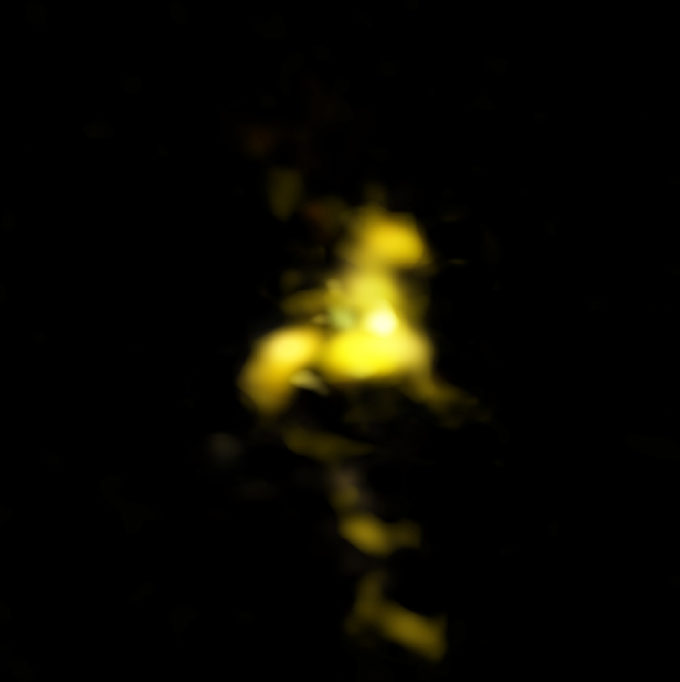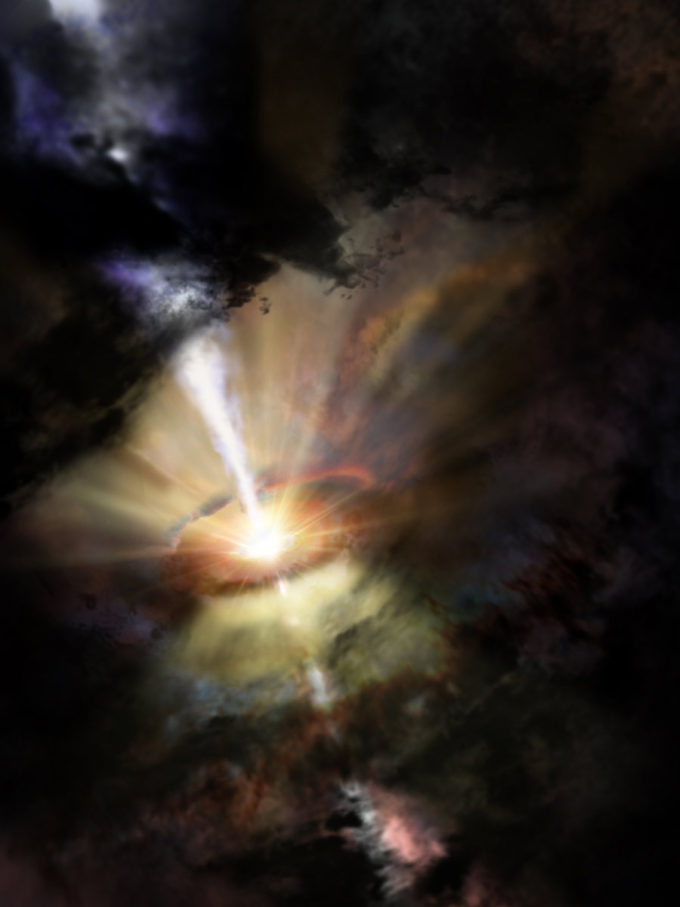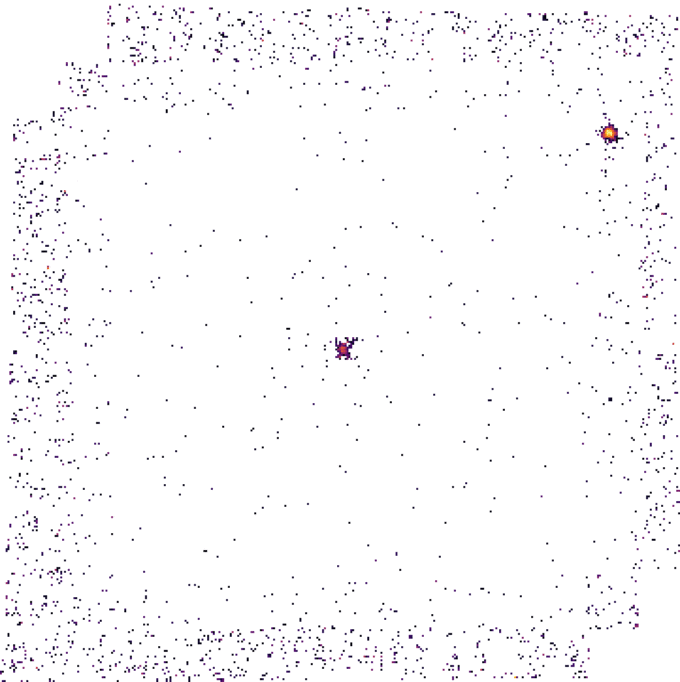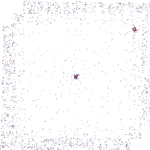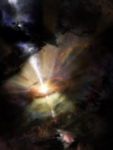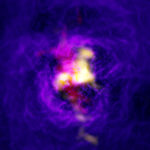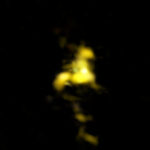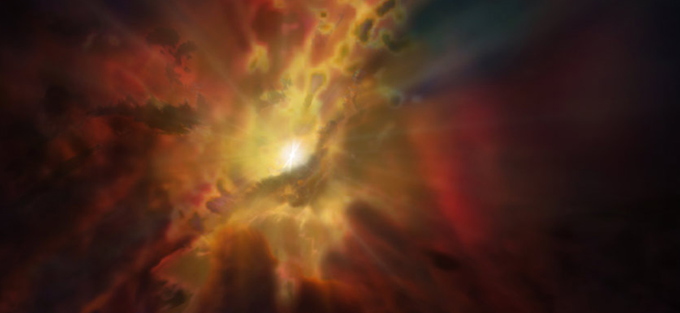Galaxy-Scale Fountain Seen in Full Glory
A billion light-years from Earth lies one of the Universe’s most massive structures, a giant elliptical galaxy surrounded by a sprawling cluster of other galaxies known as Abell 2597. At the core of the central galaxy, a supermassive black hole is powering the cosmic equivalent of a monumental fountain, drawing in vast stores of cold molecular gas and spraying them back out again in an ongoing cycle.
Astronomers have long theorized that fountains such as this continually recirculate a galaxy’s star-forming fuel. New Atacama Large Millimeter/submillimeter Array (ALMA) observations of Abell. 2597 show the first clear and compelling evidence for the simultaneous infalling and outflow of gas driven by a supermassive black hole. The researchers report their observations in the latest issue of the Astrophysical Journal.
“The supermassive black hole at the center of this giant galaxy acts like a mechanical ‘pump’ in a water fountain,” said Grant Tremblay, an astrophysicist at the Harvard-Smithsonian Center for Astrophysics in Cambridge, Massachusetts, and lead author on the paper. “This is one of the first systems in which we find clear evidence for both cold molecular gas inflow toward the black hole and outflow or uplift from the jets that the black hole launches.”
According to the researchers, this entire system operates via a self-regulating feedback loop. The infalling material provides power for the fountain as it “drains” toward the central black hole, like water entering the pump of a fountain. This infalling gas then causes the black hole to ignite with activity, launching high-velocity jets of super-heated material that shoot out of the galaxy. As it travels, this material pushes out clumps and streamers of gas into the galaxy’s expansive halo, where it eventually rains back in on the black hole, triggering the entire process anew.
In total, about three billion solar masses of molecular gas are part of this fountain, forming a filamentary nebula that spans the innermost 100,000 light-years of the galaxy.
In an earlier study by the same authors published in the journal Nature, the researchers were able to verify the interconnection between the black hole and the galactic fountain by observing the region across a range of wavelengths, or portions of the spectrum. By studying the location and motion of molecules of carbon monoxide (CO) with ALMA, which shine brightly in millimeter-wavelength light, the researchers could measure the motion of the gas as it falls in toward the black hole.
Earlier data from the Multi-Unit Spectroscopic Explorer (MUSE) on ESO’s Very Large Telescope (VLT) revealed warm, ionized gas being expelled from the galaxy – essentially the plume of the fountain. The new ALMA observations found clumps of cold, molecular gas in precisely the same locations as the warm gas seen in the earlier observations.
“The unique aspect here is a very detailed coupled analysis of the source using data from ALMA and the MUSE. The two facilities make for an incredibly powerful combination,” said Tremblay. “ALMA revealed the distribution and motions of the cold molecular gas clouds, and MUSE did the same for the warm ionized gas.”
The ALMA and MUSE data were combined with a new, ultra-deep observation of the cluster by NASA’s Chandra X-ray Observatory, revealing the hot phase of this fountain in exquisite detail, noted the researchers.
The observations also very convincingly support the hypothesis that the warm ionized and cold molecular nebulas are one-in-the-same, with the warm ionized gas merely being the “shell” around the cold molecular cores that churn within this galaxy-scale fountain.
This multiwavelength approach offers an uncommonly complete picture of this system. “It’s like observing the rain cloud, rain, and puddle all at the same time,” noted Tremblay. While this is just one observation of one galaxy, the astronomers speculate that they may be observing a process that is common in galaxies and fundamental to their evolution.
Additional Information
This research is presented in a paper titled “A Galaxy-scale Fountain of Cold Molecular Gas Pumped by a Black Hole” by G. Tremblay et al. in the Astrophysical Journal. [https://iopscience.iop.org/article/10.3847/1538-4357/aad6dd ]
The research team was composed by G. R. Tremblay [1,2,27,] F. Combes [3], J. B. R. Oonk [4,5], H. R. Russell [6], M. A. McDonald [7], M. Gaspari [8,28], B. Husemann [9], P. E. J. Nulsen [1,10], B. R. McNamara [11], S. L. Hamer [12], C. P. O’Dea [13,14], S. A. Baum [14,15], T. A. Davis [16], M. Donahue [17], G. M. Voit [17], A. C. Edge [18], E. L. Blanton [19], M. N. Bremer [20], E. Bulbul1, T. E. Clarke [21], L. P. David [1], L. O. V. Edwards [22], D. Eggerman [2], A. C. Fabian [6], W. Forman [1], C. Jones [1], N. Kerman [2], R. P. Kraft [1], Y. Li [23,24], M. Powell [2], S. W. Randall [1], P. Salomé [3], A. Simionescu [25], Y. Su [1], M. Sun [26], C. M. Urry [2], A. N. Vantyghem [11], B. J. Wilkes [1], and J. A. ZuHone [1].
[1] Harvard-Smithsonian Center for Astrophysics, 60 Garden St., Cambridge, MA 02138, USA.
[2] Yale Center for Astronomy and Astrophysics, Yale University, 52 Hillhouse Ave., New Haven, CT 06511, USA
[3] LERMA, Observatoire de Paris, PSL Research Univ., College de France, CNRS, Sorbonne Univ., Paris, France.
[4] ASTRON, Netherlands Institute for Radio Astronomy, P.O. Box 2, 7990 AA Dwingeloo, The Netherlands.
[5] Leiden Observatory, Leiden University, P.O. Box 9513, 2300 RA Leiden, The Netherlands.
[6] Institute of Astronomy, Cambridge University, Madingley Rd., Cambridge, CB3 0HA, UK
[7] Kavli Institute for Astrophysics and Space Research, Massachusetts Institute of Technology, 77 Massachusetts Avenue, Cambridge, MA 02139, USA.
[8] Department of Astrophysical Sciences, Princeton University, Princeton, NJ 08544, USA.
[9] Max-Planck-Institut für Astronomie, Königstuhl 17, D-69117 Heidelberg, Germany.
[10] ICRAR, University of Western Australia, 35 Stirling Hwy, Crawley, WA 6009, Australia.
[11] Physics & Astronomy Department, Waterloo University, 200 University Ave.W., Waterloo, ON, N2L, 2G1, Canada.
[12] CRAL, Observatoire de Lyon, CNRS, Université Lyon 1, 9 Avenue Ch. André, F-69561 Saint-Genis-Laval, France.
[13] Department of Physics & Astronomy, University of Manitoba, Winnipeg, MB R3T 2N2, Canada.
[14] School of Physics & Astronomy, Rochester Institute of Technology, 84 Lomb Memorial Drive, Rochester, NY 14623, USA.
[15] Faculty of Science, University of Manitoba, Winnipeg, MB R3T 2N2, Canada.
[16] School of Physics & Astronomy, Cardiff University, Queens Buildings, The Parade, Cardiff, CF24 3AA, UK.
[17] Michigan State University, Physics and Astronomy Dept., East Lansing, MI 48824-2320, USA.
[18] Department of Physics, Durham University, Durham, DH1 3LE, UK.
[19] Astronomy Department and Institute for Astrophysical Research, Boston University, 725 Commonwealth Ave., Boston, MA 02215, USA.
[20] H.W. Wills Physics Laboratory, University of Bristol, Tyndall Avenue, Bristol, BS8 1TL, UK.
[21] Naval Research Laboratory Remote Sensing Division, Code 7213 4555 Overlook Ave SW, Washington, DC 20375, USA.
[22] Physics Department, California Polytechnic State University, San Luis Obispo, CA 93407, USA.
[23] Center for Computational Astrophysics, Flatiron Institute, 162 Fifth Ave., New York, NY 10027, USA.
[24] Department of Astronomy, University of Michigan, 1085 S. University Ave., Ann Arbor, MI 48109, USA.
[25] Institute of Space and Astronautical Science (ISAS), JAXA, 3-1-1 Yoshinodai, Chuo-ku, Sagamihara, Kanagawa, 252-5210, Japan.
[26] Department of Physics & Astronomy, University of Alabama in Huntsville, Huntsville, AL 35899, USA.
[27] Einstein Fellow.
[28] Einstein & Spitzer Fellow.
The Atacama Large Millimeter/submillimeter Array (ALMA), an international astronomy facility, is a partnership of the European Organisation for Astronomical Research in the Southern Hemisphere (ESO), the U.S. National Science Foundation (NSF) and the National Institutes of Natural Sciences (NINS) of Japan in cooperation with the Republic of Chile. ALMA is funded by ESO on behalf of its Member States, by NSF in cooperation with the National Research Council of Canada (NRC) and the Ministry of Science and Technology (MOST) in Taiwan and by NINS in cooperation with the Academia Sinica (AS) in Taiwan and the Korea Astronomy and Space Science Institute (KASI).
ALMA construction and operations are led by ESO on behalf of its Member States; by the National Radio Astronomy Observatory (NRAO), managed by Associated Universities, Inc. (AUI), on behalf of North America; and by the National Astronomical Observatory of Japan (NAOJ) on behalf of East Asia. The Joint ALMA Observatory (JAO) provides the unified leadership and management of the construction, commissioning and operation of ALMA.
Images
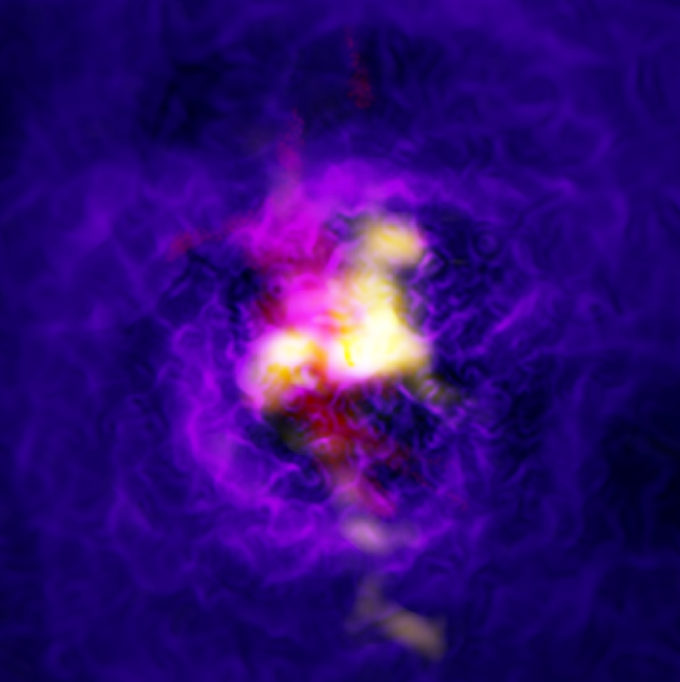
Composite image of the Abell 2597 galaxy cluster showing the fountain-like flow of gas powered by the supermassive black hole in the central galaxy. The yellow is ALMA data of the cold gas. The red is data from the Very Large Telescope showing the hot hydrogen gas in the same region. The extend purple is the extended hot, ionized gas as imaged by the Chandra X-ray Observatory. Credit: ALMA (ESO/NAOJ/NRAO), Tremblay et al.; NRAO/AUI/NSF, B. Saxton; NASA/Chandra; ESO/VLT
Contacts
-
Nicolás Lira
Education and Public Outreach OfficerJoint ALMA Observatory, Santiago - ChilePhone: +56 2 2467 6519Cel: +56 9 9445 7726Email: [email protected] -
Charles E. Blue
Public Information OfficerNational Radio Astronomy Observatory Charlottesville, Virginia - USAPhone: +1 434 296 0314Cel: +1 202 236 6324Email: [email protected] -
Masaaki Hiramatsu
Education and Public Outreach Officer, NAOJ Chile -
Calum Turner
ESO Assistant Public Information Officer

